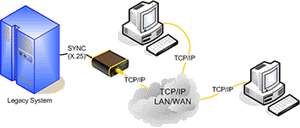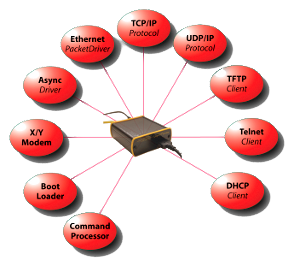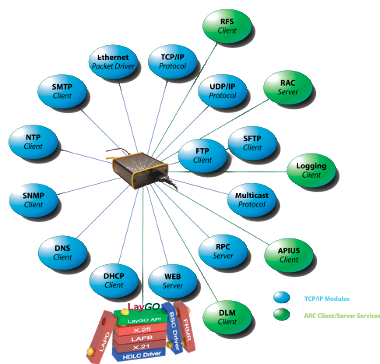PXSe Protocol eXchange Server – Ethernet
What is it?
The PXSe is an Ethernet to synchronous adaptor or gateway. Connected directly to a computer’s Ethernet port or indirectly through an Ethernet switch, the PXSe can provide synchronous communication just as an internal synchronous adaptor does. Its true strength is its operation as an autonomous gateway, tunnel, bridge, switch, RPC server or other type of communication server, including as a data line monitor. Synchronous protocols, such as LAPB, LAPD, X.25, Bisynchronous and Monosynchronous are supported through our LayGO multiprotocol host services that can operate either on the host computer or the PXSe.
Ethernet, an Alternative for Internal Adaptors
Nearly all PCs today come with built in Ethernet ports, and the operating systems support the full TCP/IP protocol suite. Because of the wide use of Ethernet, the PXSe is a true alternative for disappeared synchronous adaptors. Each Ethernet port can be converted by the PXSe to one or two synchronous ports, and exchange TCP/IP to synchronous protocol services, such as X.25, LAPB or just raw mode HDLC. These services can also be shared among multiple workstations.


The PXSe connected to a Legacy Host’s synchronous port(s) exchanges the physical connection to Ethernet, and the synchronous protocol to TCP/IP or UDP. Protocol exchange can be done on any layer, physical, link, network or higher. This exchange does not affect the legacy host system’s synchronous hardware or software.
Synchronous Ports
The serial port(s) are synchronous and use one or two built in high density Hirose connectors, configurable for RS-232, RS-422, RS-485, X.21 or V.35. RS-232 supports 128 kbps; RS-422/485 and V.35 support 8.192 Mbps (E2). Standard straight (male) and X-Over (female) cables are available for all common interfaces. On request, we can deliver customized cables.
The PXSe supports bit synchronous and byte synchronous mode. Bit synchronous can be bit transparent or HDLC/SDLC; byte synchronous can be Bisynchronous (BSC) or Monosynchronous. Data encoding can be NRZ, NRZI, FM0, FM1 or Manchester. Each PXSe port can be independently configured as DTE or DCE, RS-232, RS-422 or V.35, HDLC or Bi-Synchronous, X.25/LAPB or X.25/LAPD, etc.
The PXSe as a Synchronous Adapter
The PXSe can act exactly as a PC internal synchronous adaptor by using an RPC-like interface between the LayGO® API (RPC client) and the LayGO stack running inside the PXSe (RPC server). Since communication between RPC client and server normally uses TCP/IP/Ethernet, LayGO® applications from any LAN workstation can access the PXSe either locally (TCP/IP LAN) or remotely (TCP/IP WAN). In the latter situation, protocol delays through the network may occur.
PXSe Software Components
In addition to the eCos® Real Time Operating System (RTOS) and built-in TCP/IP support, the PXSe uses LayGO®, our highly modular multi-protocol stack (X.25, LAPB, LAPD, NRM, Frame Relay and proprietary). Besides HDLC, we support drivers for SDLC, bit-transparent, Bisynchronous and Monosynchronous modes. The combined use of LayGO® and TCP/IP services provides a great variety of communication solutions.
Out of the box, the PXSe provides a full range of remote client and server services:
- Web server to update or reconfigure the PXSe.
- RAC server (Remote Application Control) to control the PXSe running application.
- Log Client to submit logging information to a remote log server.
- APIUS (Automatic PXSe Installation and Update Service) client to automatically install and update the PXSe software and CPLD hardware configuration.
- DLM client to monitor data lines between the PXSe and the target system at the physical, link, network and application layers.
- SMTP or SNMP client to send e-mail (SMS) or trap messages about potential communication problems.
RedBoot Loader
When powered on, the PXSe executes a Power-On Self-Test (POST), then it loads and executes a version of the RedBoot bootstrap environment.
If no RedBoot commands are issued during a configurable time-out interval (default 15 seconds), RedBoot loads and executes the LayGO® server application.
RedBoot offers a CLI for basic configuration and firmware updates

The 4 MB Flash Memory is organized as a non-hierarchical disk containing 64 x 64 KB sectors. The first three sectors are protected and contain RedBoot and its loader, the last two sectors contain the Flash Image System (FIS) directory and configuration data. RedBoot includes basic terminal, TCP/IP, and TFTP support.
PXSe LayGO® Server
The PXSe flash memory contains a LayGO® server application statically linked to eCos , a multithreaded RTOS (Real Time Operating System). eCos includes a complete TCP/IP stack and support for HTTP, DHCP, FTP, DNS, SMTP, SNMP, and NTP.
At the physical layer, the PXSe exchanges synchronous and Ethernet data.
At the Ethernet level, the primary higher protocol is TCP/IP or UDP. The synchronous ports can be either bit-synchronous (transparent or raw mode HDLC/SDLC) or byte synchronous (Bisynchronous or Monosynchronous).

In bit-synchronous HDLC/SDLC mode, switching can be done on any protocol supported by LayGO®: X.21, X.21bis, HDLC/LAPB, HDLC/LAPD, Frame Relay, NRM, X.25/LAPB, X.25/LAPD, and X.25/LAPB/Frame Relay (Annex G).
The LayGO® protocol software and applications can run either on the PXSe, on the host or on a combination of the two. We have implemented an RPC-like interface between the PXSe and the LayGO® API, allowing customers to run existing LayGO® applications unmodified, using the PXSe as a synchronous adapter.
The Solutions page shows several PXSe applications.
[Last updated February 21st, 2024]